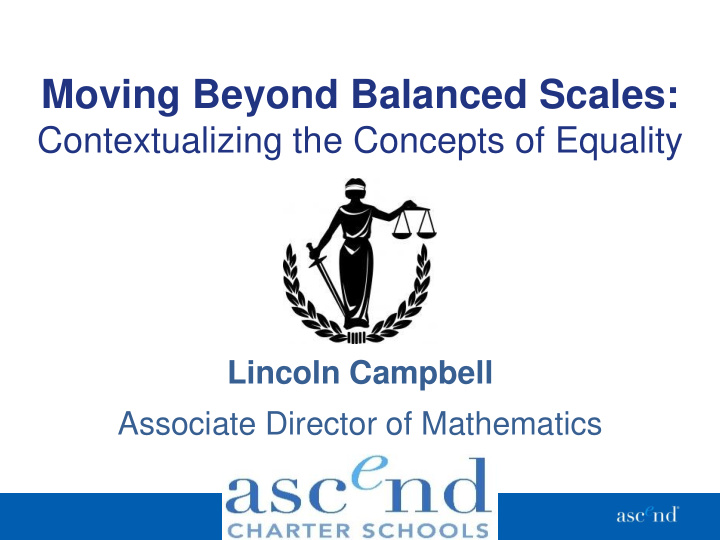



Moving Beyond Balanced Scales: Contextualizing the Concepts of Equality Lincoln Campbell Associate Director of Mathematics
Overview I. Why is Equality Important? II. How well do Students Understand Equality? III. How do Misconceptions about Equality Form? IV. How can we Address Equality Misconceptions?
I. Why is Equality Important?
The Importance of Equality
II. How well do Student Understand Equality?
Do Now Think, Pair, Share: How would students in your class respond to the following question: What number would you put in the box to make this a true number sentence?
Actual Student Responses Student Responses / Percent Responding □ = 7 □ = 12 □ = 17 □ = 12 and 17 1 st and 2 nd 5% 58% 13% 8% Grade 3 rd and 4 th 9% 49% 25% 10% Grade 5 th and 6 th 2% 76% 21% 2% Grade Carpenter, Frank, Levi et al, Thinking Mathematically 2003
What Students Think about the Equal Sign Turn and Talk: Anticipate how your students would answer each question. Knuth, Alibali, Hattikudur et al, Mathematics Teaching in the Middle School 2008
Actual Student Responses Think, Pair, Share : How would you categorize the student responses in groups A, B and C? A - B - RELATIONAL OPERATIONAL • “It means that what is to the left • “What the sum of the two and right of the sign mean the numbers are” (Grade 6) • “A sign connecting the answer to same thing” (Grade 6) • “The same as, same value” (Grade the problem” (Grade 7) • “The total” (Grade 8) 7) • “The left side of the equals sign • “How much the numbers added and the right side of the equals together equal” sign are the same value” (Grade 8) C - OTHER • “It means equal to” • “3 plus 4 equals 7” Knuth, Alibali, Hattikudur et al, Mathematics Teaching in the Middle School 2008
III. How do Misconceptions about Equality Form?
Introducing the Equal Sign • When is the equal sign first introduced in Common Core State Standards? • Work with addition and subtraction equations. CCSS.MATH.CONTENT.1.OA.D.7 Understand the meaning of the equal sign, and determine if equations involving addition and subtraction are true or false. For example, which of the following equations are true and which are false? 6 = 6, 7 = 8 - 1, 5 + 2 = 2 + 5, 4 + 1 = 5 + 2.
Analyzing Concepts of Equality in Textbooks
IV. How can we Address Equality Misconceptions?
Concepts of Equality Routine • Students are engaged in a discussion about the meaning of the equal sign. • The context of this discussion is true/false and open number sentences. • The number sentences provide a focus for students to articulate their ideas and to challenge their conceptions. • The discussions assist in developing ways of thinking and communicating that embody the principles of algebraic reasoning. • Students articulate mathematical principles that often are not explored or stated. • Students must justify the principles that they propose in ways that convince others, and they must recognize and resolve conflicting assumptions and conclusions.
Video of David While you watch, listen to David’s explanation to see determine how he understands the equal sign. What teacher moves did the teacher use to push relational and algebraic thinking?
Concepts of Equality Routine Alex has $20.50 in his bank account and makes a $7.25 withdrawal. Greg has $19.50 in his bank account and makes a $6.25 withdrawal. Do Alex and Greg both have the same amount of money in their accounts now? 20.50 + (-7.25) = 19.50 + (-6.25) Apply and extend previous understandings of operations with fractions. CCSS.MATH.CONTENT.7.NS.A.1 Apply and extend previous understandings of addition and subtraction to add and subtract rational numbers; represent addition and subtraction on a horizontal or vertical number line diagram.
Equality Strings Running Equality Strings (wrong): 3 + 5 = 8 + 2 = 10 + 5 vs. Valid Equality Strings (right): 3 + 5 = 6 + 2 = 8 + 0
Adding Context and Movement If the left side of a bench press has two 10 pound weights and two 5 pound weights and the rights side of the bar has one 25 pound weight, how much more weight should be added so that the weight on both sides of the bar are equal? This could be expressed as: 10 + 10 + 5 + 5 = 25 + x
Key Takeaways • Instead of “equals” say “is the same as” • Instead of saying x or box, say “what number?” or “some number” • Use Concepts of Equality Routine Strings • Use Equality Strings • Make meaning through Context
Resources Concepts of Equality Routine Strings San Diego Public Schools, Mathematics Routines Bank September 2004 (online link) Carpenter, Thomas P., Megan Loef. Franke, and Linda Levi. Thinking Mathematically: Integrating Arithmetic and Algebra in Elementary School . Portsmouth, NH: Heinemann, 2003. Print. Knuth, Mcneil, Stephens, et al. "The Importance of Equal Sign Understanding in the Middle Grades." Mathematics Teaching in the Middle School 13.9 (2008): n. pag. Web.
Closing Thoughts: Connecting Liberal Arts to Math
Mathematical, Moral and Legal Equality Westen, Peter Speaking of Equality : An Analysis of the Rhetorical Force of `Equality' in Moral and Legal Discourse, Princeton University Press, Jul 14, 2014
Questions? Find out more about how we do math at Ascend! Lincoln Campbell Associate Director of Mathematic lcampbell@ascendlearning.org
Recommend
More recommend